Dr. Sameep Sohoni – Best Robotic Joint Replacement Surgeon in Mumbai, Thane

Robotic joint replacement surgery is an innovative and efficient solution to joint pain, providing patients with numerous benefits, including greater accuracy, faster recovery times, and customized implants. Suppose you are looking for a robotic joint replacement surgeon in Mumbai. In that case, Dr. Sameep Sohoni, Orthopedist in Thane, is an expert in his field, providing patients with the highest care and attention.
Now before we dig into how Dr. Sameep Sohoni is the best for Robotic Joint Replacement Surgery in Thane, Mumbai… we think its important for people to be aware about… what Robotic Joint Replacement Surgery is actually… how it is conducted… its advantages and disadvantages… and several other associated things…
What is Robotic Joint Replacement Surgery?
Robotic joint replacement surgery is a minimally invasive surgery using robotic arm assisted knee replacement surgery. During surgery, the robotic arm is then used to perform the surgery, helping to ensure precise and accurate placement of the joint implant. Robotic joint replacement surgery offers several benefits over traditional joint replacement surgery, including greater accuracy and precision, smaller incisions, reduced blood loss, and potentially shorter recovery times.
Dr. Sameep Sohoni (Top Orthopedic Doctor in Thane, Mumbai) do make use of highly enhance Robot system to conduct artificial joint surgery…
The Robot system comprises most advanced surgical equipment capable of 3D pre-planning, virtual surgery and precise cutting to facilitate accurate & precise surgery results.
The robot system is highly user-friendly, comprising values of Innovative, Flexibility & Easiness of usage… with the basic offering of accuracy and safety at its best.
Dr. Sameep's Used Robot System Comprised Equipment Includes:
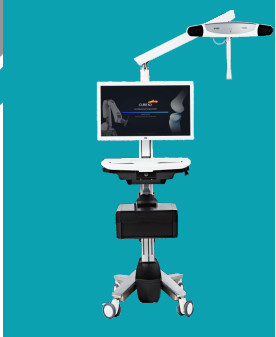
Main Console
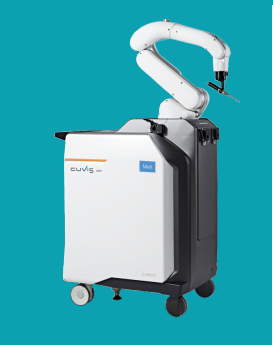
Robotic Arm

Planner
- System Monitor
- Optical Tracking System
- Operating Software
- Main Controller
- Robot Arm
- Milling Tool
- Irrigation
- Surgical Planning Software
Joint Robot System Key Features...
Here below find… awesome features of Joint Robot System used by Dr. Sameep Sohoni… These features makes Dr. Sameep the ultimate best Robotic Joint Replacement Doctor in Mumbai, Thane.
Product & Class: Automation Robot Surgical System (Class 3)
Planning: 3D CT Base surgical planning
Cutting:
- Fully Automatic Cutting (Milling)
- No Cutting Guides (jigs) required
- Tibial cut including keel preparation
- Fully finished femur with all the cuts & peg holes
Safety: Emergency stop & Manual guide
Detection: OTS (Optical Tracking System)
Robot Cutting: Max. 50mm/sec
Robot Precision: Repeat Precision < 0.5mm / Positioning accuracy < 1mm
Other Features:
- Wide surgical space and high freedom (6axis articulated robot)
- Patient-Robot Position Guide (Surgical space check)
- Speed control during cutting
- Compact hardware, minimize product space
Why Dr. Sameep's Robotic Artificial Joint Surgery is Best?
Here below find, how Dr. Sameep Sohoni performs the best Robotic Joint Replacement Surgery in Mumbai, Thane…
Personalized pre-planning
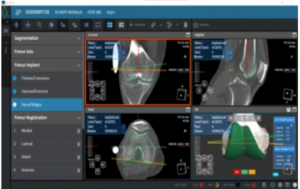
As each person has a different face, the shape of bone is also different. Meril’s artificial joint surgical robot CUVIS Joint® shows the patient’s bone in 3D images, and the doctor can use those images for pre-planning of surgery personalized for the patient.
Pre-selection of artificial joint and precise insertion of artificial joint

What’s as important as the precise surgical plan is to select and insert the personalized artificial joint. The doctor uses robot to select an artificial joint for the patient and insert it accurately.
Precise cutting for sub-millimeter accuracy and optimum alignment
 Precise cutting serves the optimum result. CUVIS Joint® provides the correct alignment of a patient’s leg axis with the sub-millimeter dimensional accuracy and precise cutting for the optimal surgical outcome.
Precise cutting serves the optimum result. CUVIS Joint® provides the correct alignment of a patient’s leg axis with the sub-millimeter dimensional accuracy and precise cutting for the optimal surgical outcome.
Reduction of side effect and reoperation
 CUVIS Joint® reduces side effects like inequality of limb length, pulmonary embolism, and fracture. The risk of infection is also reduced because of fewer instruments in use than in conventional surgery.
CUVIS Joint® reduces side effects like inequality of limb length, pulmonary embolism, and fracture. The risk of infection is also reduced because of fewer instruments in use than in conventional surgery.

Pre-selection of artificial joint and precise insertion of artificial joint
What’s as important as the precise surgical plan is to select and insert the personalized artificial joint. The doctor uses robot to select an artificial joint for the patient and insert it accurately.

Precise cutting for sub-millimeter accuracy and optimum alignment
Precise cutting serves the optimum result. CUVIS Joint® provides the correct alignment of a patient’s leg axis with the sub-millimeter dimensional accuracy and precise cutting for the optimal surgical outcome.

Reduction of side effect and reoperation
CUVIS Joint® reduces side effects like inequality of limb length, pulmonary embolism, and fracture. The risk of infection is also reduced because of fewer instruments in use than in conventional surgery.

This is the heading
Lorem ipsum dolor sit amet, consectetur adipiscing elit. Ut elit tellus, luctus nec ullamcorper mattis, pulvinar dapibus leo.
Robotic Joint Knee Replacement Process

Step 1
Patients can decide upon robotic artificial joint surgery after consulting with the doctor
Step 2
CT Scanning
Step 3
The scanned CT image is converted into a 3D image for diagnosing the patient’s condition and make a surgical plan as required.

Step 4
The patient is connected to the robot and stabilized for surgery. In the next stage, the doctor performs registration process to verify if the 3D image of the patient matches the original surgery site.
After registration process, robot reviews the data and cuts the bone precisely with respect to size, position, angle and direction of the implant decided during pre-surgery planning stage.
Step 5
Insert and fix the decided implant for surgery conclusion.
Advantages of Robot Joint System Used By Dr. Sameep

Simplicity
Flexibility
- Bone registration using probe
- Improved workspace check
- 3D bone model generation with fast & easy CT image data
- UI design considering user convenience
- Reduce the surgery preparation time - 3D modeling, Non-Sterile/Sterile Diagnosis
- Various cutting options - Full and partial cutting-change order
- Intra-operative Gap Check -Pre/Intra/Post
- Plan changing, Gap Balancing possible


Safety
Accuracy
- Real-time system monitoring Emergency stop & force freeze Manual guide of robot arm
- Precise pre-surgical planning executed every time
- Sub-millimeter dimensional accuracy
- Optimal Alignment
Is Robotic Knee Replacement Surgery Successful?
Lorem ipsum dolor sit amet, consectetur adipiscing elit. Ut elit tellus, luctus nec ullamcorper mattis, pulvinar dapibus leo.
The procedure allows for more accurate and precise implant placement, resulting in better alignment and a more natural feel. As a result, patients who undergo robotic knee replacement surgery often experience less pain, faster recovery times, and an improved range of motion compared to traditional knee replacement surgery. While the success rate of the surgery can depend on several factors, including the skill and experience of the surgeon… in general, robotic knee replacement surgery is an effective and safe treatment option for many patients.
Is There Robotic Surgery For Knee Replacement?
Yes, there is a type of surgery known as robotic-assisted knee replacement or robotic knee replacement, which uses a robotic arm to assist the surgeon in performing the procedure. This type of surgery is becoming increasingly popular and is considered a less invasive and more accurate alternative to traditional knee replacement surgery.
During robotic knee replacement surgery, the surgeon uses a specialized computer system to create a 3D model of the patient’s knee joint, which is used to create a customized surgical plan. The surgeon then uses a robotic arm to cut and shape the bone, remove damaged cartilage and tissue, and place the knee implant.
The robotic arm has sensors and cameras that give the surgeon real-time feedback and help ensure precise and accurate implant placement. This can lead to better outcomes, a shorter recovery time, and less pain for the patient than traditional knee replacement surgery.
It’s important to note that only some orthopedic surgeons are trained to perform robotic knee replacement surgery, which may only suit some patients. However, for suitable candidates, robotic knee replacement surgery can offer several benefits and may be an excellent option.
Is Robotic Knee Replacement Surgery Better Than Traditional?
Robotic knee replacement surgery offers several benefits over traditional knee replacement surgery, including greater accuracy and precision, smaller incisions, reduced blood loss, and potentially shorter recovery times. While it may not be suitable for all patients, robotic knee replacement surgery can be a highly effective and efficient option for those who are good candidates.
Advantages of Robotic Knee Replacement
Robotic knee replacement surgery offers several advantages over traditional knee replacement surgery. Some of the most significant advantages of robotic knee replacement include the following:

Greater accuracy
One of the most significant advantages of robotic knee replacement surgery is that it allows for greater accuracy in positioning and placing the implant. The robotic arm can create a highly detailed 3D model of the patient's knee joint, which the surgeon can use to plan and execute the procedure with exceptional precision. This can lead to a better fit and improved overall function of the knee.

Customized Implants
Another advantage of robotic knee replacement surgery is that it allows for customized implants to be created for each patient. The 3D model of the patient's knee joint can create a highly personalized implant that precisely fits the patient's anatomy. This can lead to a better fit and reduced risk of complications.

Faster Recovery Times
Robotic knee replacement surgery typically involves less trauma to the surrounding tissue and bone, leading to faster recovery times. Patients may experience less pain and swelling and can return to normal activities more quickly than traditional knee replacement surgery

Reduced Risk of Complications
Because robotic knee replacement surgery allows for greater accuracy and precision, there is a reduced risk of complications such as implant loosening, dislocation, or infection. The reduced trauma to surrounding tissue and bone can also lead to a lower risk of complications such as blood loss, nerve damage, and scarring.

Improved overall outcomes
Robotic knee replacement surgery has been shown to lead to improved overall outcomes for patients, including improved range of motion, reduced pain, and improved overall function of the knee joint.
Short-Coming of Robotic Knee Replacement
While robotic knee replacement surgery offers several advantages over traditional knee replacement surgery, there are also some potential disadvantages. Some of the most significant disadvantages of robotic knee replacement surgery include the following:

Cost
Robotic knee replacement surgery can be more expensive than traditional knee replacement surgery due to the different technology and specialized equipment required. But robotic knee replacement in Mumbai is less costly.

Learning Curve
Robotic knee replacement surgery requires specialized training and experience; not all surgeons may be familiar with the technology. This can lead to a longer learning curve and potentially higher complication rates during the early stages of a surgeon's experience with the technology.

Limited Availability
Not all hospitals or healthcare facilities may offer robotic knee replacement surgery, meaning patients may need to travel to find a qualified best knee replacement surgeon in Mumbai or the best robotic knee replacement in India
Success Rate of Robotic Knee Replacement
The success rate of robotic knee replacement surgery is high, with studies showing that the procedure leads to improved outcomes and longer-lasting results. In addition, the precision and accuracy of the surgery can lead to better alignment and a more natural feel to the joint, which can improve mobility and reduce pain.
Types of Robotic Knee Replacement
Several robotic knee replacement surgery types are available, each utilizing different technologies and techniques. Some of the widely used robotic knee replacement surgeries include:
MAKO Plasty
This type of robotic knee replacement surgery uses the MAKO system, which includes a robotic arm and specialized software. The system creates a 3D model of the patient’s knee joint, which the surgeon can use to create a customized surgical plan. For example, during the mako robotic arm assisted surgery for total knee replacement, the robotic arm assists the surgeon in removing damaged tissue and positioning the implant precisely.
ROSA Knee System
The ROSA Knee System is another robotic knee replacement surgery type that uses advanced technology to create a 3D model of the patient’s knee joint. This system uses real-time data to help the surgeon precisely position the implant and ensure optimal alignment. The ROSA Knee System is known for its accuracy and ability to reduce surgical time and complications.
NAVIO Surgical System
The NAVIO Surgical System uses a handheld robotic tool to assist the surgeon in performing knee replacement surgery. The system creates a 3D model of the patient’s knee joint, which the surgeon can use to plan the procedure. The robotic tool then assists the surgeon in removing damaged tissue and positioning the implant precisely.
Robotic-Arm Assisted Surgery
This robotic knee replacement surgery utilizes a robotic arm attached to the operating table. The surgeon uses a handheld controller to move the robotic arm, which assists in removing damaged tissue and positioning the implant precisely. This surgery has been shown to improve accuracy and reduce the risk of complications.
You Might Refer Reading: Hip Replacement Doctor in Thane
Robotic Knee Replacement Cost
The expense of a knee replacement surgery using robots may differ based on various aspects, including the surgical approach employed, the location of the hospital, and the surgeon’s experience. However, robotic knee replacement cost in india is generally more expensive than traditional knee replacement surgery. But the best robotic knee replacement cost in Mumbai can be less expensive.
Robotic Knee Replacement Reviews
Many patients undergoing robotic knee replacement surgery report positive results, including faster recovery times, less pain, and improved mobility. However, as with any surgery, there can be risks and potential complications, so discussing the procedure with the best Knee Replacement Surgeon in Thane and carefully considering your options is essential.
Dr. Sameep Sohoni: Best Robotic Joint Replacement Doctor in Mumbai, Thane
 Dr. Sameep Sohoni is a highly experienced Orthopedic Doctor in Thane, known for his robotic joint replacement surgery expertise. He is regarded as one of Thane’s best knee replacement surgeonsand has helped countless patients overcome joint pain and disability. Dr. Patil is exceptionally skilled in performing robotic-assisted knee replacement surgery, which offers several advantages over traditional knee replacement surgery, including greater accuracy and precision, reduced blood loss, and potentially faster recovery times.
Dr. Sameep Sohoni is a highly experienced Orthopedic Doctor in Thane, known for his robotic joint replacement surgery expertise. He is regarded as one of Thane’s best knee replacement surgeonsand has helped countless patients overcome joint pain and disability. Dr. Patil is exceptionally skilled in performing robotic-assisted knee replacement surgery, which offers several advantages over traditional knee replacement surgery, including greater accuracy and precision, reduced blood loss, and potentially faster recovery times.
Patients who have undergone knee replacement surgery with Dr. Sameep Sohoni have left positive reviews and testimonials, praising his knowledge, skill, and compassionate bedside manner. To book an appointment with Dr. Patil, patients can quickly contact his office through his website or phone. His office is conveniently located in Thane, making it easy for patients in the surrounding areas to access his services. If you are looking for the best knee replacement surgeon in thane, Dr. Sameep Sohoni is a top choice.
What is the Recovery Time for Robotic Knee Replacement?
The duration of recuperation after a knee replacement surgery using robots can differ based on multiple factors, including the patient’s age, overall health, the extent of the surgery, and whether any complications occur during or after the procedure. In general, however, patients can expect a recovery time of several weeks to several months after robotic knee replacement surgery.
Immediately following surgery, patients typically spend several days in the hospital for observation and pain management. Patients will work with a physical therapist to begin exercises designed to promote mobility and reduce swelling during this time.
Once discharged from the hospital, patients will continue to work with a therapist or a walker for several weeks to support their weight while the knee joint heals. Patients will also need to perform exercises at home to maintain flexibility and strength in the knee joint.
Patients can generally expect to resume normal daily activities, such as driving or light work, within 4-6 weeks after surgery. However, more strenuous activities, such as running or heavy lifting, may need to be avoided for several months to allow the knee joint to heal fully.
Overall, recovery time for robotic knee replacement surgery can be shorter than with traditional knee replacement surgery due to the less invasive nature of the procedure. However, patients must follow their surgeon’s instructions carefully and take the time to allow their knee joints to heal fully before resuming normal activities.
How is a Robotic Knee Replacement Done?
A robotic knee replacement surgery is typically done using the following steps:
Preoperative planning
 Before the surgery, the patient will undergo a CT scan or MRI to create a 3D knee joint model. This model creates a customized surgical plan that considers the patient’s unique anatomy and the extent of the knee damage.
Before the surgery, the patient will undergo a CT scan or MRI to create a 3D knee joint model. This model creates a customized surgical plan that considers the patient’s unique anatomy and the extent of the knee damage. Anesthesia
 The patient will be given general anesthesia or a spinal block to numb the lower half of the body. The joint replacement surgeon will then place the robotic arm, which is equipped with sensors and a camera, over the surgical area.
The patient will be given general anesthesia or a spinal block to numb the lower half of the body. The joint replacement surgeon will then place the robotic arm, which is equipped with sensors and a camera, over the surgical area.
Incision
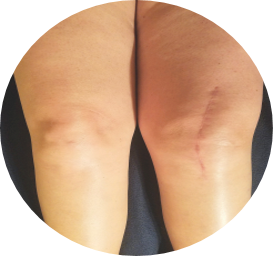 The surgeon will make a small incision near the knee joint and use specialized instruments to remove damaged bone and cartilage. The joint replacement surgeon will then place the robotic arm, which is equipped with sensors and a camera, over the surgical area.
The surgeon will make a small incision near the knee joint and use specialized instruments to remove damaged bone and cartilage. The joint replacement surgeon will then place the robotic arm, which is equipped with sensors and a camera, over the surgical area. Calibration
 The robotic arm will be calibrated to the patient’s unique anatomy using the 3D model created during the preoperative planning stage.
The robotic arm will be calibrated to the patient’s unique anatomy using the 3D model created during the preoperative planning stage.
Bone preparation
 The surgeon will use the robotic arm to prepare the bone surface to receive the knee implant. The robotic arm helps to ensure precise bone cuts and implant placement.
The surgeon will use the robotic arm to prepare the bone surface to receive the knee implant. The robotic arm helps to ensure precise bone cuts and implant placement. Implant placement
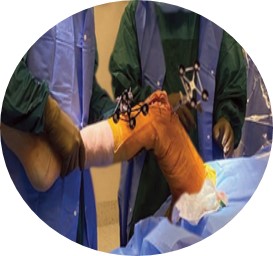 The surgeon will use the robotic arm to guide the placement of the knee implant, ensuring that it is properly aligned and positioned.
The surgeon will use the robotic arm to guide the placement of the knee implant, ensuring that it is properly aligned and positioned. Closure
 The surgeon will close the incision using sutures or staples.
The surgeon will close the incision using sutures or staples.
Following surgery, the patient will be monitored in the hospital for several days before being discharged. A physical therapist will work with the patient to begin rehabilitation exercises designed to promote mobility and strength in the knee joint.
Overall, robotic knee replacement surgery is an exact and accurate procedure that can offer several benefits over traditional knee replacement surgery. However, it requires specialized training and experience and may not be suitable for all patients.
If you or a family member is considering knee replacement surgery, consider the benefits of robotic surgery and consult with an expert like Dr. Sameep Sohoni from Thane. With his expertise in robotic joint replacement surgery, he is the best Robotic Joint Replacement Surgeon in Mumbai, Thane, who help you achieve better outcomes and get back to a pain-free, active lifestyle.
FAQ Related To Robotic Joint Replacement Surgery
Many patients report experiencing less pain and discomfort after undergoing robotic knee replacement surgery, as the smaller incisions required can result in less damage to healthy tissue and faster healing. Additionally, the precision and accuracy of the surgery can lead to improved alignment and a more natural feel to the joint, which can reduce pain and discomfort.
Muscles are not cut during robotic knee replacement surgery, as it is a minimally invasive technique involving smaller incisions than traditional knee replacement surgery. Instead, the robotic arm cuts and shapes the bone without damaging surrounding tissues. This can result in less trauma to the soft tissues, reduced blood loss, and potentially faster recovery times for patients.
This is generally faster than traditional knee replacement surgery, which can take up to 3 hours or more. However, the exact duration of the surgery will depend on various factors, including the surgeon’s experience, the patient’s anatomy, and the type of implant being used.

